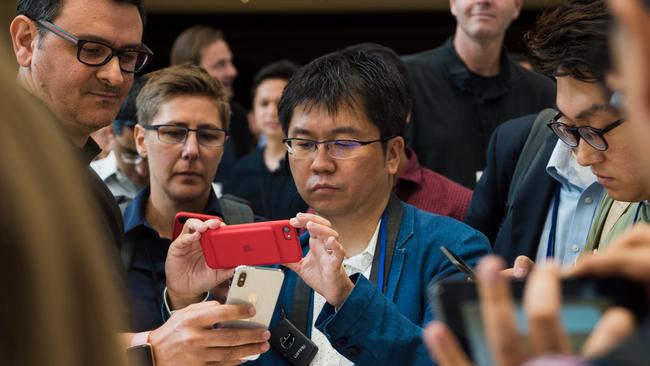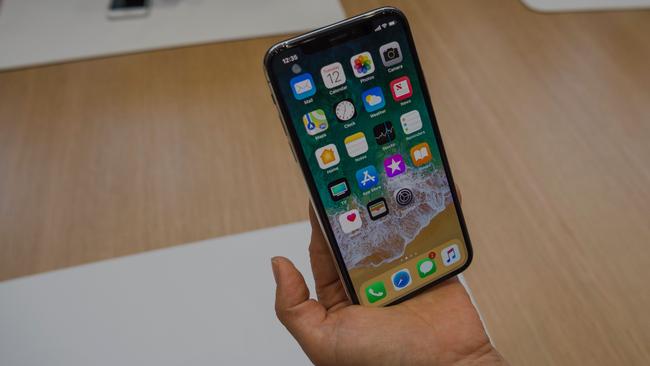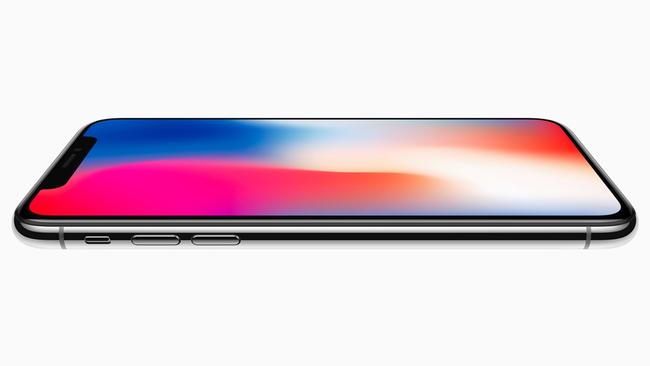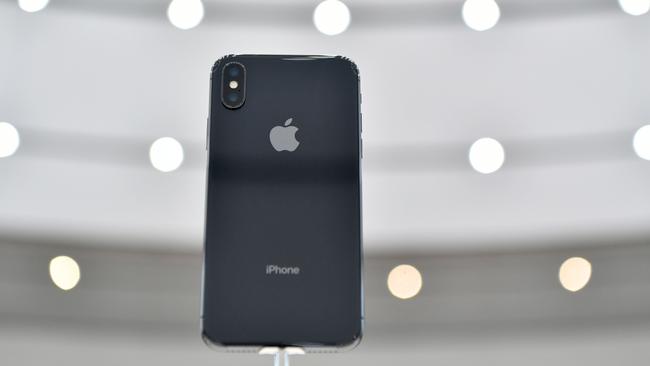First Australian review: Is the Apple iPhone X worth buying and does Face ID really work?
IT’S the world’s most expensive smartphone but is Apple’s iPhone X worth buying? We put everything from Face ID to Animoji to the test to find out.
Smartphone
Don't miss out on the headlines from Smartphone. Followed categories will be added to My News.
SORRY. The old iPhone can’t answer your call right now. Why? ‘Cause it’s dead.
Just like New Taylor Swift, the Apple iPhone X has resurrected itself with a refined image, greater sophistication, just a hint of controversy, and a significantly more grown-up appearance.
Even Kanye would approve of its finish.
But, like New Taylor Swift, the 10th anniversary iPhone makes dramatic changes that could challenge its fan base.
Its Home button really is dead, its software is familiar but works differently, the screen is bigger in some ways and smaller in others, and that display is brighter but partially obstructed.
It’s the biggest iPhone redesign in the past decade — just like Apple users hoped — but it also has the potential, and price, to divide devotees.

So can Apple shake off the haters and attract more players with the iPhone X?
We’ve been secretly testing the handset for a week, recording sneaky videos, dunking it in water, charging it wirelessly, posing as a talking poo, swiping, sweeping, and tapping its OLED screen, and almost constantly staring into its True Depth camera to find out before its November 3 launch.
THE BIGGEST CHANGE OF ALL
To paraphrase Dorothy, there’s just no place like Home on this smartphone.
It’s the first iPhone in history that’s missing a Home button, the first one in years without a fingerprint sensor, and the change is likely to leave you momentarily befuddled.
Without a button on its face, you can’t just click and watch this smartphone spring to life.
Now you must unlock the phone with your face, and sweep a thumb up the screen to begin.
Apple software engineering senior vice-president Craig Federighi says this gesture makes more sense because your thumb is then midway up the screen, ready to select an app, and get started. He also claims it happens in fractions of a second.

Mercifully, he’s right on both counts, and the new swiping gesture is one of many that feel more natural on this reconsidered iPhone.
You close apps by swiping down its screen, summon Siri by holding its side button, and the best gesture of all is reserved for switching between apps.
Slide a finger right along the bottom of the screen and this phone will seamlessly present all the apps you’ve opened before. It’s speedy, easy to perform, and a huge improvement on the last method.
With this software update, Apple has done the implausible. The company removed a feature and turned it into an opportunity to create a genuine software improvement.
Of course, it takes time to adjust to these new gestures and learn new shortcuts, but they should be natural after your first day with the iPhone X. After that, you’ll need to adjust every time you use an ‘old’ iPhone.
YOUR FACE IS YOUR PASSWORD
First, there were PIN codes, then there were patterns, then fingerprints, and then iris scans.
Smartphone makers have experimented with many ways of keeping troublemakers from stealing your information (or just Facejacking) but Apple says its method is the future of phone security.
It’s also one of the most controversial parts of this phone. Will Face ID recognise you? What if you wear sunglasses? What if you grow a beard? What if you wake up with puffy eyes? Will you miss Touch ID?
The iPhone X uses an advanced mix of technologies to scan your face in three dimensions, including an infra-red camera, a flood illuminator, and dot projector.
You register your face twice with the iPhone to set it up, drawing a circle in the air with your nose like you’re Mr Squiggle, and it then scans your face each time you wake and look at the phone.
A lock icon on the home screen indicates when the phone knows it’s you, though you can swipe up the screen to force a scan.

A lot is riding on Face ID. It’s the only way to unlock Apple’s premium iPhone without entering an old-school PIN.
Happily, it most often works first time regardless of lighting, environment, or family resemblance (I tested it on my mother).
Face ID is also a quick way to verify your identity and, because it’s baked into Apple developer software, works with any app that now accepts Touch ID as security.
Australian banking apps, for example, can be unlocked by looking at this phone, as can online shopping passwords you’ve saved in Apple’s Safari browser.
There are times that Face ID doesn’t work, however, and it has a learning curve.
If you’re standing with the sun shining behind you, if you cover your mouth, eyes or nose, or if a severe shadow falls across your head, Face ID might not recognise you and will request your PIN.
While it recognised me with spectacles, it took a couple of attempts to recognise me without them. I entered my PIN both times and the iPhone X neural engine has since adapted to my altered appearance.
The same issue occurred when I swept my fringe off my face. A couple of attempts later, it’s adjusted to my hairstyles.

It’s worthwhile noting that Face ID will unlock your phone from a generous angle. You don’t need to hold it in front of your face as with Samsung’s iris scanner, and you don’t need to pick it up from a table.
As a guide, if you could take a selfie of your whole face from that angle, Face ID will unlock your phone.
This advanced technology also powers Animoji, a new feature in Apple’s Messages app that tracks your facial movements and mimics them in an animated emoji of your choosing.
More usefully, Apple uses Face ID to lock down details of your notifications. Their content only appears when the phone recognises your face, so no nosy passers-by can’t read your text messages.
BIGGER, SMALLER AND BETTER SCREEN
Apple hardware engineering senior vice-president Dan Riccio says the company has always envisioned an iPhone that was ”all display, edge-to-edge” and this handset pretty much achieves it.
Its body is only slightly larger than the iPhone 8, is significantly shorter than the iPhone 8 Plus, yet it packs in a 5.8-inch screen that stretches all the way into its rounded corners.
And that screen is both brighter and filled with more pixels than its predecessors. Apple uses OLED technology for the first time in this iPhone and supports High Dynamic Range content.
Side by side with its iPhone 8 competitor, it looks brighter, more detailed, and offers greater contrast.

When it comes to screen size, however, big phone fans should take care.
While the iPhone X screen sounds much bigger than the iPhone 8 Plus on paper, the reality is slightly different.
Its display is actually more than 6mm narrower than its big brother and, while it’s 13mm taller, some of that real estate belongs to the so-called ‘notch’ that houses Face ID’s sensors.
If an app hasn’t been upgraded to use all of Apple’s screen, and appears with black borders atop and below, it will look smaller on this phone than on a Plus iPhone.
The screen reduction is particularly noticeable when you type into this phone. The narrow display shrinks the keyboard space.
This is by no means a deal-breaker, and the more narrow phone is easier to slip into a jeans pocket, but phablet fans should prepare themselves for a change.
That ‘notch’ is also an unavoidable part of this smartphone. It has to be there to deliver Face ID, though it can be a minor distraction, particularly when you first start using the phone, and it appears to bulge on the left side.
BETTER CAMERAS FRONT AND BACK
The biggest beneficiary of camera upgrades in the iPhone X will be your selfie game.
Apple adds Portrait Lighting mode to the seven-megapixel front camera of this phone and it can make a huge difference to how the world sees you.
This mode, even in beta, accurately and artfully blurs the background of your shot more often than not and lets you change the lighting around your face.

It makes your selfies stand out, and can even give the impression that someone else took them for you.
The iPhone X’s 12-megapixel rear camera also adds dual optical image stabilisation (rather than single OIS on the 8 Plus) for less movement blur in images, and its addition is most useful when capturing video.
The telephoto lens in the iPhone X also adds a wider, f2.4 aperture.
POLISHING THE APPLE
While not headline-making, there are a lot of refinements in the iPhone X.
Its body features toughened glass front and back, which might scare some clumsy users but does enable wireless charging.

Its shiny stainless steel edges offer a premium finish that hark back to the days of the iPhone 3G, its redesigned speakers deliver more volume and an impressive studio effect, it supports augmented reality apps, and it’s just as water-resistant as other recent models.
While Apple doesn’t reveal all of its specifications, it does admit this phone’s battery won’t last quite as long between charges as the 8 Plus, though it will outlast the iPhone 7 by two hours.
In our tests, the battery lasted into the night every day we used it, though it needed a recharge about the time we did.
APPLE IPHONE X VERDICT
Is the world’s most expensive smartphone worth buying? It’s certainly worth considering.
Unlocking your smartphone just by looking at it is inarguably convenient, and the new gestures to open and navigate Apple apps are more natural than before and pleasantly addictive.
The longer 5.8-inch screen is also bolder, brighter and better to view, its body feels well made but modestly sized, and its front camera will improve your Instagram efforts.
Its screen is not as big as it seems on paper, however, and you will have to enter your PIN more often while Face ID adjusts to your countenance. At $1829 for the top model, it’s also a big investment in debut technology.
The iPhone X doesn’t feel like Version 1.0 or technology trial, however, but rather the successful reinvention of an old favourite, and the realisation of Apple’s early goals.
Existing iPhone users, in particular, should find a happy ‘home’ in this device; the first iPhone without a physical manifestation of one.
Apple iPhone X
$1579-$1829
apple.com/au
4.5 out of 5 stars
PROS:
— Face ID is secure, convenient and quick
— Fluid, improved software changes
— Larger, brighter screen that extends into its corners
— More compact, premium form
— Smarter selfies in Portrait Lighting mode
— Dual image stabilisation on rear cameras
— Wireless charging
CONS:
— Highest price on the market
— Narrower display than iPhone 8 Plus
— Face ID needs training
— Glass front and back
— No headphone jack
— Smaller battery
— Only available in black or white
Originally published as First Australian review: Is the Apple iPhone X worth buying and does Face ID really work?



